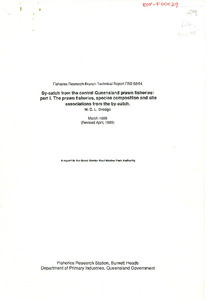Please use this identifier to cite or link to this item:
https://hdl.handle.net/11017/3784By-catch from the central Queensland prawn fisheries: Part 1. The prawn fisheries, species composition and site associations from the by-catch

View this entry
Full metadata record
| DC Field | Value | Language |
|---|---|---|
| dc.contributor.author | Dredge, M.C.L. | - |
| dc.coverage.spatial | central Queensland | en |
| dc.date.accessioned | 2021-03-08T02:01:25Z | - |
| dc.date.available | 2021-03-08T02:01:25Z | - |
| dc.date.copyright | 1989 | en |
| dc.date.issued | 1989 | en |
| dc.identifier.uri | https://hdl.handle.net/11017/3784 | - |
| dc.description | On cover -- "March 1988 (Revised April, 1989)". | en |
| dc.description.abstract | [Extract from the 1989 report] A study of trawl fisheries between 18°S and 19°S has shown that three fisheries for penaeid prawns, separable on the basis of species composition and geographic distribution, can be described. More than 300 trawlers operate in these fisheries, which have generated landings in excess of 2000 tonnes of prawns per year in the past two years. The fisheries also take a considerable quantity of by-catch, little of which is of commercial value. In a two year study of by-catch fauna, 477 taxa were identified. The trawl by-catch was dominated by Crustacea and Osteichthyes (bony fish) in terms of numbers and weight taken. The Osteichthyes were the most diverse group, with more than 50% of species coming from this Class. The by-catch was dynamic in nature, with relatively few species being present throughout the year, and dominant species changing over time. There were, however, characteristic faunal assemblages which appeared to be associated with coastal, near-reef and inshore waters. The coastal fauna was markedly different to the near-reef and inshore faunas, and the transition between the two occurred over a distance of less than 5 km. There was no such clear boundary between the near-reef and inshore faunas, the fauna of some sites grouping with near-reef fauna on some sampling occasions and with inshore fauna on others. Preliminary comparisons of the faunas from trawl grounds and the reef environment showed marked differences between them. Few species were common to the reef environment and to trawl grounds, and families which were dominant on trawl grounds were relatively less abundant in near-reef environments. | en |
| dc.publisher | Queensland Department of Primary Industries | en |
| dc.relation.ispartofseries | Report to the Great Barrier Reef Marine Park Authority | en |
| dc.rights | © Queensland Government. | en |
| dc.title | By-catch from the central Queensland prawn fisheries: Part 1. The prawn fisheries, species composition and site associations from the by-catch | en |
| dc.type | Report | en |
| dc.subject.asfa | Prawn fisheries | en |
| dc.subject.asfa | By-catch | en |
| dc.format.pages | 45 | en |
| dc.publisher.place | Burnett Heads | en |
| dc.subject.collection | Managing Multiple Use | en |
| dc.relation.connectiontogbrmpa | GBRMPA contributed to this item | en |
| dc.subject.category | Commercial fisheries | en |
| dc.subject.category | Fishers | en |
| Appears in Collections: | Management | |
Files in This Item:
| File | Description | Size | Format | |
|---|---|---|---|---|
| 1989-By-Catch-Central-Queensland-Prawn-Fisheries-Part1-Species-Composition-Site-Association.pdf | Main document (PDF) | 28.24 MB | Adobe PDF |  View/Open |
Items in the ELibrary are protected by copyright, with all rights reserved, unless otherwise indicated.
